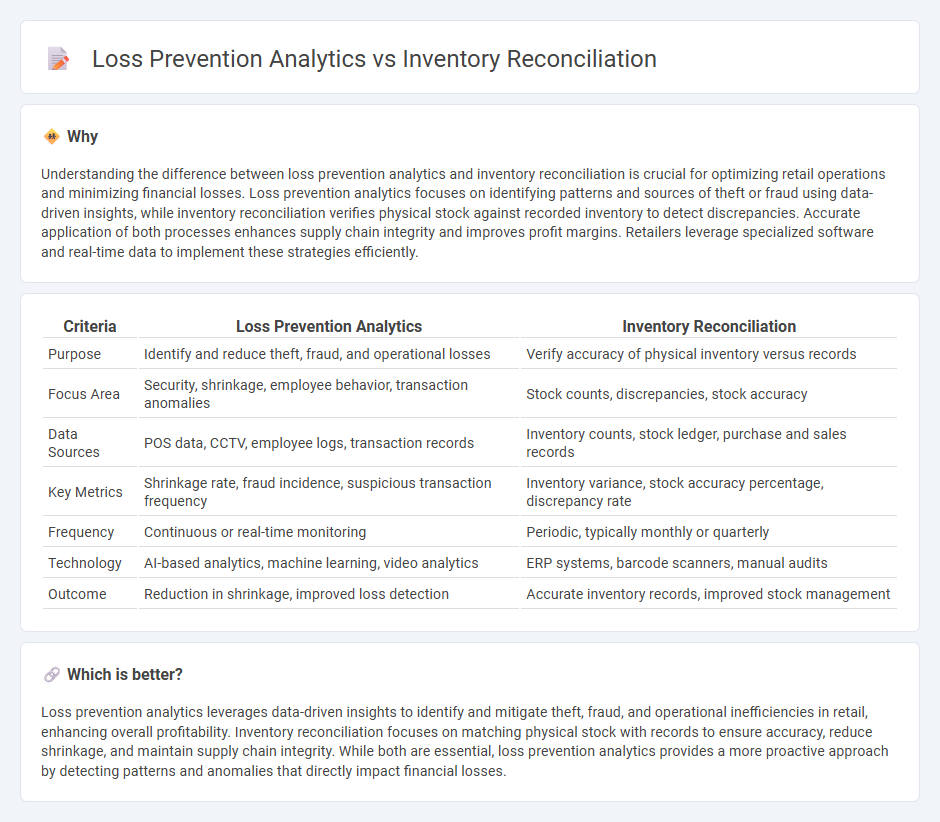
Loss prevention analytics focuses on identifying and mitigating theft, fraud, and operational inefficiencies in retail environments through advanced data analysis and real-time monitoring. Inventory reconciliation involves systematically comparing physical stock counts with recorded inventory to detect discrepancies and ensure accurate stock management. Explore how integrating these strategies enhances retail accuracy and profitability.
Why it is important
Understanding the difference between loss prevention analytics and inventory reconciliation is crucial for optimizing retail operations and minimizing financial losses. Loss prevention analytics focuses on identifying patterns and sources of theft or fraud using data-driven insights, while inventory reconciliation verifies physical stock against recorded inventory to detect discrepancies. Accurate application of both processes enhances supply chain integrity and improves profit margins. Retailers leverage specialized software and real-time data to implement these strategies efficiently.
Comparison Table
| Criteria | Loss Prevention Analytics | Inventory Reconciliation |
|---|---|---|
| Purpose | Identify and reduce theft, fraud, and operational losses | Verify accuracy of physical inventory versus records |
| Focus Area | Security, shrinkage, employee behavior, transaction anomalies | Stock counts, discrepancies, stock accuracy |
| Data Sources | POS data, CCTV, employee logs, transaction records | Inventory counts, stock ledger, purchase and sales records |
| Key Metrics | Shrinkage rate, fraud incidence, suspicious transaction frequency | Inventory variance, stock accuracy percentage, discrepancy rate |
| Frequency | Continuous or real-time monitoring | Periodic, typically monthly or quarterly |
| Technology | AI-based analytics, machine learning, video analytics | ERP systems, barcode scanners, manual audits |
| Outcome | Reduction in shrinkage, improved loss detection | Accurate inventory records, improved stock management |
Which is better?
Loss prevention analytics leverages data-driven insights to identify and mitigate theft, fraud, and operational inefficiencies in retail, enhancing overall profitability. Inventory reconciliation focuses on matching physical stock with records to ensure accuracy, reduce shrinkage, and maintain supply chain integrity. While both are essential, loss prevention analytics provides a more proactive approach by detecting patterns and anomalies that directly impact financial losses.
Connection
Loss prevention analytics leverages data analysis to identify patterns of theft, fraud, and operational inefficiencies within retail environments. Inventory reconciliation ensures accurate stock records by comparing physical counts with recorded inventory data, highlighting discrepancies that may indicate shrinkage. Together, loss prevention analytics and inventory reconciliation enhance retail security by detecting and addressing inventory losses, improving overall supply chain integrity.
Key Terms
**Inventory Reconciliation:**
Inventory reconciliation involves systematically comparing recorded inventory data with physical stock counts to identify discrepancies caused by errors, theft, or mismanagement. Accurate reconciliation enhances data integrity, supports financial accuracy, and informs decision-making by pinpointing stock variances. Explore how advanced reconciliation techniques can optimize inventory control and reduce operational losses.
Stock Variance
Inventory reconciliation identifies discrepancies between physical stock counts and recorded quantities to resolve stock variance issues accurately. Loss prevention analytics utilizes data-driven insights to detect patterns and causes of inventory shrinkage, aiming to reduce stock losses proactively. Explore how integrating both approaches enhances overall inventory accuracy and minimizes stock variance effectively.
Cycle Counting
Cycle counting enhances inventory reconciliation by providing systematic, periodic verification of stock levels to identify discrepancies. Loss prevention analytics complements this process by analyzing patterns and anomalies in inventory data to detect theft, damage, or errors. Explore more to understand how combining cycle counting with loss prevention analytics optimizes inventory accuracy and reduces shrinkage.
Source and External Links
How to reconcile inventory - Inventory reconciliation is the process of comparing on-hand inventory to records, identifying discrepancies, and adjusting records accordingly to ensure accuracy, control, and proper valuation, often involving recounting, identifying underlying causes, and preventing future errors.
How to Reconcile Your Inventory in 6 Steps (2024) - Inventory reconciliation involves physically counting your stock, comparing it with your inventory system, identifying discrepancies, and updating your records to ensure they reflect the actual stock available.
Inventory Reconciliation: How to Reconcile Your ... - An effective inventory reconciliation process includes physically verifying stock, comparing counts with records, investigating causes of discrepancies like errors or missing paperwork, and adjusting records to maintain inventory accuracy and control.
 dowidth.com
dowidth.com